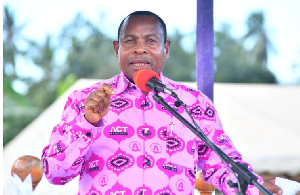Despite red flags raised by the minority in parliament, last Wednesday, parliament voted to approved the US$600 million loan facility for the Cocoa Productivity Enhancement Project being given to Ghana by the African Development Bank (AfDB) to restructure and revamp the cocoa industry.
The project which covers a seven year duration is not only aimed at significantly increasing productivity of cocoa beans from the current 900,000 metric tonnes to estimated 1.5 million metric tonnes by 2027, but most importantly to institute certain agronomic practices aimed at prevent outputs from further going down again.
In effect, expectations are that the move in securing the facility would largely contribute in the total transformation of the cocoa sector by the year 2027. Thus, with higher productivity in the sector, Ghana Cocoa Board (COCOBOD) can starts charging farmers commercial rates for their inputs in the sense that COCOCBOD has been making overall losses because of the cost of the inputs such as fertilizers and pesticides.
A number of initiatives namely mass cocoa spraying exercise, sensitization of cocoa farmers on key agronomic practices aimed at increasing yield as well as various input subsidies are expected to be carried out under the Cocoa Productivity Enhancement project. The initiatives include the following.
Fighting swollen shoot virus Disease
Instructively, the Western North Region – an area that accounts for one third of the total cocoa production in the country – produces between 300,000 metric tonnes to 350,000 metric tonnes of cocoa annually.
Last year however, the area just produced 148,000 metric tonnes as a result of the swollen shoot virus disease which largely affected lots of cocoa farms. In effect, the reduction implies a loss of 200,000 metric tonnes. Production level reduced in the region, inadvertently, it affects national production levels as well.
In an attempt to tackle the cocoa swollen shoot virus disease to ensure higher yields, about US$140.2 million investment has been earmarked from the US$600 million facility towards the course of fighting to a large extent the viral disease that is having a toll on cocoa production.
The cocoa swollen shoot virus disease is spread by infectious mealybugs and infected budwood. Report indicate that the risk of spreading the disease can largely be reduced if mealybugs and live plant material are not transported deliberately or accidentally from one place to the other.
The continuous effect on the production cycle of cocoa bean in the country has largely affected production as the cocoa swollen shoot virus disease can infect cocoa plants at any stage of development. The disease is regarded a serious impediment to the production of cocoa in the West Africa sub-region where the disease was first diagnosed many decades ago.
Domestic cocoa bean processing
Due to the practice where majority of the cocoa beans are sent outside the country in its raw state, government is taking considerable steps aimed at adding value to the cocoa bean through 50 percent domestically processing. Obviously, this measure of value addition is expected to create decent jobs in the economy which will intend bring in extra revenue. Such domestic processing with an initial allocation of US$200 million will largely transform the cocoa sector.
Importantly, representatives of the Ghana Export Promotion Authority (GEPA) recently opened a series of stakeholder discussions with officials of COCOBOD and key industry players in the cocoa sector to institute policy frameworks that will lead to increasing the quantity of cocoa beans sold to chocolate manufacturing companies in the county. The move is to enhance Ghana’s competitiveness and market share in the export of chocolate in the global market.
Currently, the quantity of cocoa beans COCOBOD sells to local processors during the major and minor crop seasons is said to be less than 30 percent of the country’s annual crop production whiles the remaining 70 percent are sold in its raw state.
The Goldstreet Business gathered that most chocolate companies prefer buying the cocoa beans during the minor crop season as against the main season. Reports indicate that minor season crop beans are sold at a certain discounted price which also comes with other additional benefits to the companies with the result that a number of such companies buy less of the cocoa beans during the main crop season.
In effect, when production of cocoa beans increases as estimated under the project, it is expected that cocoa processing companies will as well increase their intake of cocoa beans and as such may not necessarily prefer buying beans only in the minor seasons but the main season.
Notably, since Ghana and Ivory Coast are now givers of price for cocoa in the international markets instead of previously being takers of price, this measure which is expected to rake in about US$360 million annually, must afford Ghana the greatest opportunities to ensure surge in cocoa production by maintaining fresh farms and developing unproductive farms.
< b>Rehabilitation of moribund farms
One major initiative factored under the AfDB loan facility is rehabilitation of moribund farms, that is unproductive farms in the country. It is estimated that US$82.7 million is expected to be channeled into the rehabilitation process.
Currently, it is estimated that Ghana has more than 2.5 million hectres of cocoa areas of which about 1.45 million hectres are considered to be productive areas. This implies that more than 1 million hectres of cocoa areas are considered to be non-productive. In effect, cocoa farmers are still producing below expected cocoa production level due to old and moribund cocoa trees.
Majority of the farms that were in the mainstream production are no longer producing as they are now moribund. This has seriously affected the production levels of cocoa.
COCOBOD’S idea of applying hand pollination of cocoa flowers – a mechanism which is said to be the new way to increase production – as well as fighting cocoa swollen shoot virus disease are expected to yield the needed result soon as pilot project in the former started last year.
Should COCOBOD be successful in its quest to rehabilitate moribund farms and bring such farms into mainstream production, by the time this is done, COCOCBOD would have learnt new measures on how to significantly increase cocoa production in the fresh farms and apply these processes for the rehabilitated moribund farms to increase productivity per yield.
Importantly, productive cocoa farms have largely declined and this account for the reason why rehabilitation of moribund farms is seen as immediate importance to COCOBOD and key stakeholders.
Farmer database, farm irrigation
In other key areas, an estimated US$10.6 million is expected to be put into establishing farmer database whereas cocoa farm irrigation will be scaled up with an amount of US$40.6 million.
Having a database for Ghanaian cocoa farmers has become imperative in the sense that it would aid in adequate planning measures in the sector. For instance, it would enable COCOBOD to be abreast with exact number of cocoa farmers in the country and this will assist largely in terms of certain farming inputs that are earmarked for the farmers to increase yield. This will bring to a situation where some cocoa farmers complain about shortage of farming inputs among others.
Regarding irrigation, the purpose of having a modernized irrigation system for cocoa farmers is expected to assist farmers to cultivate superior crops with the water supply as per need of the crops. Importantly, Irrigation water improves water conditions in the soil, increases the water content of plant fibers, dissolves nutrients & makes them available to plants.
Some school of thought might say that the US$40.6 million investment in the irrigation sector appears to be meagre as most of crops depend on rain-fed, however, it is a step towards improving yields in the cocoa sector.
Recently, COCOBOD inaugurated a of solar-powered irrigation schemes for two cocoa farms in the Eastern Region. this is part of COCOBOD’s plans in making production of cocoa all year round. Another irrigation facility will soon come onstream.
Warehouse expansion, consumption
Out of the US$600 million loan facility, government is investing a total of US$50 into the expansion of warehouses and various storage capacity whereas US$7.5 million will be earmarked for activities to promote the consumption of cocoa products.
Consumption of cocoa products remains very low, per capita cocoa consumption of 0.52kg for Ghana as compared to about 8kg for some western countries and 100kg in China. In Africa consumption is currently low at just four percent of global consumption.
In the consumption market, the global consumption value of Cocoa and Chocolate increased at a 5.7 percent average growth rate from 2012-2017.
North America is the main consumption region due to the bigger demand for downstream applications. North America accounted for 34.21 percent of the global consumption volume in total in 2016.
In view of this, the Chief Executive Officer of Ghana Cocoa Board (COCOBOD) Joseph Boahen Aidoo noted that if at least 50 per cent of Ghana’s cocoa yield can be processed, it was important for participants to be in the forefront of the cocoa consumption campaign.
Mr Boahen Aidoo indicated that Ghanaians need to take advantage of the health and nutritional benefits of consuming cocoa, adding that Ghana cannot lose out on the benefits of cocoa whiles it produces premium quality cocoa.
Apart from the health and nutritional benefits of cocoa consumption, Ghana stands to gain when new markets like China, India and some parts of Africa are created to develop the taste for cocoa to increase revenue.
Business News of Friday, 8 November 2019
Source: goldstreetbusiness.com













